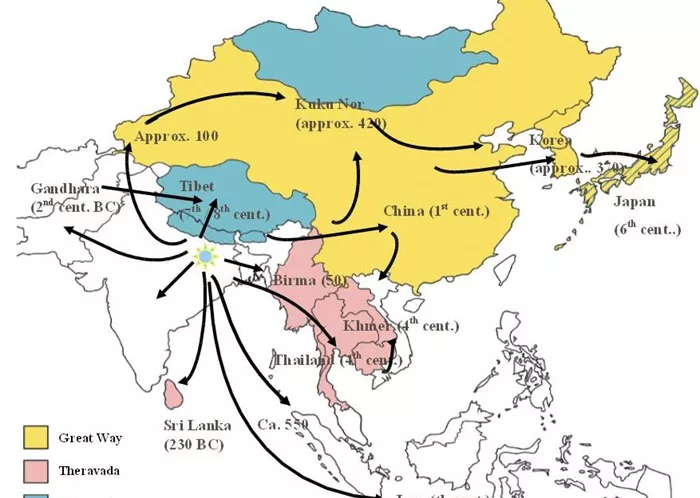Theravada Buddhism is one of the oldest branches of Buddhism. It is sometimes called the “Teaching of the Elders.” Theravada focuses on the original teachings of the Buddha and emphasizes meditation, moral conduct, and wisdom.
The Origin and History of Theravada Buddhism
Theravada Buddhism originated in India and spread to many parts of Asia. It is the oldest surviving Buddhist school, tracing back to the original Pali Canon scriptures. This tradition focuses on the individual’s path to enlightenment through strict adherence to the Buddha’s teachings. For a deeper look at its theravada buddhism origin and theravada buddhism history, many scholars recommend exploring the Pali texts and its spread across Southeast Asia.
Top 10 Countries Practicing Theravada Buddhism
1. Sri Lanka
Sri Lanka is the heartland of Theravada Buddhism. It has preserved the Pali Canon and monastic traditions for over two thousand years. The majority of Sri Lankans practice Theravada, and many important Buddhist festivals and pilgrimages take place here. Temples and monasteries in Sri Lanka keep the teachings alive, with monks dedicating their lives to meditation and study.
2. Thailand
Thailand is perhaps the most famous country for Theravada Buddhism. Nearly 95% of Thai people follow this tradition. Buddhist teachings deeply influence Thai culture, art, and daily life. The Thai monastic order, known as the Sangha, plays a key role in education and community service. Many travelers visit Thailand to see its stunning Buddhist temples and participate in meditation retreats.
3. Myanmar (Burma)
Myanmar has one of the largest Theravada Buddhist populations in the world. Buddhism here is not just a religion but a way of life. The country has thousands of monasteries where monks study and teach the Dhamma. Myanmar is known for its strong emphasis on Vipassana meditation, a key practice in Theravada Buddhism. The Shwedagon Pagoda in Yangon is one of the most sacred sites for Buddhists.
4. Cambodia
Cambodia’s Theravada Buddhist tradition dates back many centuries. It survived difficult times, including war and turmoil, and remains the country’s dominant religion. The Cambodian people show great respect for the Sangha and the Buddha’s teachings. Angkor Wat, while originally Hindu, is now also a symbol of Cambodia’s Buddhist heritage.
5. Laos
In Laos, Theravada Buddhism is practiced by over 60% of the population. The religion shapes the country’s festivals, customs, and moral values. Lao monks are highly respected, and many young men spend time as monks to learn about Buddhism and community service. The temples in Laos are often simple but full of deep spiritual meaning.
6. Bangladesh
Though Bangladesh is mostly Muslim, it has a notable Theravada Buddhist minority, especially among ethnic groups like the Chakma and Marma in the Chittagong Hill Tracts. These communities preserve Theravada traditions through local monasteries and festivals, maintaining a strong cultural identity.
7. Nepal
Nepal is known as the birthplace of the Buddha, but it also has a Theravada Buddhist community, especially among the Newar people in the Kathmandu Valley. Theravada Buddhism in Nepal is growing, with many monasteries and centers dedicated to teaching meditation and Pali scriptures.
8. Bhutan
While Bhutan is primarily Vajrayana Buddhist, there are pockets where Theravada Buddhism is practiced or studied. The country values all Buddhist traditions and supports learning and meditation, including the Theravada path, which influences some communities near the border with India and Nepal.
9. Malaysia
Malaysia has a small but active Theravada Buddhist community, mainly among the ethnic Thai and Sinhalese populations. Temples and meditation centers in Malaysia teach Theravada principles, offering a peaceful place for practice amid a multicultural society.
10. India
India, the birthplace of the Buddha, has pockets of Theravada Buddhism mainly among certain tribal groups in the northeast and some revival movements. Although Theravada is a minority here, its historical importance and recent growth through Buddhist centers and schools are significant.
The Influence of Theravada Buddhism in These Countries
Cultural and Social Impact
In these countries, Theravada Buddhism shapes culture, art, ethics, and social life. Monks often serve as teachers and community leaders. Buddhist festivals like Vesak bring people together to honor the Buddha’s life and teachings. Meditation centers attract both locals and tourists, spreading awareness of Buddhist wisdom worldwide.
Preservation of Theravada Teachings
The countries listed work hard to preserve Theravada’s ancient scriptures and traditions. Monasteries keep the Pali texts safe and teach the Dhamma to new generations. Through education, meditation, and community activities, Theravada Buddhism continues to grow and adapt to modern life without losing its essence.
Conclusion
Theravada Buddhism remains alive and thriving in many countries, especially in South and Southeast Asia. From Sri Lanka to Myanmar and Thailand, it offers a clear path based on the Buddha’s original teachings. Understanding where Theravada is practiced helps us appreciate its deep spiritual heritage and cultural influence. For those interested in learning more about its origin and history, exploring theravada buddhism origin is a great starting point.

